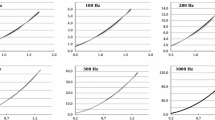Summary
This paper deals with the numerical modelling of electromagnetic losses in electrical machines, using electromagnetic field computations, combined with advanced material characterisations. Due to the complexity of this objective, simplified settings, deliberately choosen by physical arguments, must be considered first. The idea is to proceed gradually to the actual problem of an electrical machine through intermediate models showing physical relevance on their own. The numerical methods used to solve these various problems mainly involve modified finite element-finite difference discretisations, which properly take into account the nonlinear and memory properties of the magnetic material. To this end, one must start from suitable variational formulations of the underlying magnetic field problems. The combined magnetodynamic-hysteresis models are validated in several ways, particularly by comparison of numerically obtained electromagnetic losses with experimental results.
Similar content being viewed by others
References
F. Preisach (1935), “Uber the magnetisch Nachwirkung,”Zeitschrift fur Physik,94, 277–302.
G. Biorci and D. Pescetti (1958), “Analytical theory of the behaviour of Ferromagnetic Materials,”Il Nuovo Cimento,7, 829–842.
D. Jiles and D. Atherton (1984), “Theory of ferromagnetic hysteresis,”J. Appl. Phys.,55, 2115–2120.
E. Stoner and E. Wohlfarth (1991), “A Mechanism of magnetic hysteresis in Heterogeneous Alloys,”IEEE Transactions on Magnetics,27, 3475–3518.
R.D. Pillsbury (1983), “A Three Dimensional Eddy Current Formulation using two potentials: the Magnetic Vector Potential and total Magnetic Scalar Potential,”IEEE Transactions on Magnetics,19, 2284–2287.
J.S. Van Welij (1985), “Calculation of Eddy Currents in Terms of H on Hexahedra,”IEEE Transactions on magnetics,21, 2239–2241.
T. Nakata (1984), “Numerical Analysis of flux and loss distributions in electrical machinery,”IEEE Transactions on Magnetics,20, 1750–1755.
F. Brailsford and R. Fogg (1964), “Anomalous losses in cold reduced grain oriented transformer steel,”Proceedings IEE,111, 1463–1467.
G. Bertotti (1992), “Dynamic Generalisation of the Sealar Preisach model of Hysteresis,”IEEE Transactions on Magnetics,28, 2599–2601.
I.D. Mayergoyz (1991).Mathematical Models of Hysteresis Springer Verlag, New York.
I.D. Mayergoyz and G. Friedman (1987), “Isotropie vector Preisach model of hysteresis,”Journal of Apolied Physics 61, 4022–4024.
D. Halliday and R. Resnick (1981),Fundamental of Physics, John Wiley & Sons, New York.
J.C. Bavay and J. Verdun (1991), “Alliages fer-silicium,”Technique de l'ingenieur,D2-1, Schiltigheim, Strassbourg, 2110-(1-10)
D. Philips, L. Dupré and J. Melkebeek (1994), “Magneto-dynamic field computation using a rate-dependent Preisach model,”IEEE Transactions on Magnetics 30, 4377–4379.
L. Dupré, R. Van Keer, J. Melkebeek (1997). “Modelling and identification of the iron losses in non-oriented steel laminations using the Preisach theory,”IEE Proceedings, Electric Power Applications,144, 227–334.
L. Dupré, R. Van Keer, J. Melkebeek (1996), “On a numerical method for the evaluation of electromagnetic losses in electric machinery,”International journal for numerical methods in engineering,39, 1535–1553.
V. Ostovic (1989),Dynamics of Saturated Electric Machines, Springer-Verlag, Berlin.
D. Philips, L. Dupré, R. Van Keer (1990), “Computation of magnetic fields in electric machinery using a coupled finite element-network element method”,Proc. ECMI-90 Conf., pp. 325–329.
D. Philips, E. Loukipoudis, L. Dupré, J. Melkebeek (1992), “A parametric design method for computed aided design of electric machinery,”Journal of Engineering design,3, 255–267.
G. Grellet (1989), “Pertes dans des machines tournantes,”Technique de l'ingenieur,D3-II, Schiltigheim, Strassbourg 3450-(1-23).
P.G. Ciarlet and J.L. Lions (edits) (1991),Numerical analysis-volume 2: Finite Element Methods (Part 1), North-Holland, Amsterdam.
R. Van Keer, L. Dupré, J. Melkebeek (1996), “On a Numerical model for magnetic field computations with non-local boundary conditions,”Journal of Computational and Applied Mathematics,72, 179–191.
G.F. Carey and J.T. Oden (1983),Finite Elements Volume II (a second course), Prentice Hall inc., England Cliffs, New Jersey.
D. Philips, L. Dupré, J. Cnops and J. Melkebeek (1994), “The Application of the Preisach Model in Magnetodynamics: Theoretical and Practical Aspects,”Journal Magnetism Magnetic Materials,133, 540–543.
P.A. Raviart and J.M. Thomas (1994)Introduction à l'Analyse Numérique des Equations aux Dérivées Partielles (deuxième tirage), Masson Paris.
K.H., Huebner, E.A. Thornton, T.G. Byrom (1995),The finite element method for engineers (3rd edition), John Wiley, New York.
D. Philips, L. Dupré, J. Melkebeek (1995), “Comparison of Jiles and Preisach hysteresis models in magnetodynamics”IEEE Transactions on Magnetics,31, 3551–3553.
D. Philips, L. Dupré (1996), “Macroscopic Fields in Ferromagnetic Laminations taking into account Hysteresis and Eddy Current Effects,”Jounal of Magnetism and Magnetic Materials,160, 5–10 (invited paper).
L. Dupré, R. Van Keer, J. Melkebeek (1996), “On a Magnetodynamic Model for the Iron Losses in non-oriented Steel Laminations,”Journal of Physics D: Applied Physics,29, 855–861.
L. Dupré, R. Van Keer, J. Melkebeek (1995), “On a Mathematical model for the Electromagnetic Losses in Electric Machinery,”Journal of Mathematical Modelling of Systems,1, 63–74.
G.F. Carey and J.T. Oden (1984),Isimite Elements Volume III (Computational a pects), Prentice Hall inc., England Cliffs, New Jers y.
L. Dupré, R. Van Keer, J. Melkebeek (1997) “A 2D Finite Element Procedune for Magnetic Field Analysis taking into account Vector Preisach Model”Journal of Mathematical Problems in Engineering,3, 267–286.
L. Dupré, R. Van Keer, J. Melkebeek (1997), “An iron loss model for electrical machines using the Preisach theory”IEEE Transactions on Magnetics, september issue,33, 4158–4160.
Author information
Authors and Affiliations
Rights and permissions
About this article
Cite this article
Van Keer, R., Dupré, I. & Melkebeek, J. Computational methods for the evaluation of the electromagnetic losses in electrical machinery. Arch Computat Methods Eng 5, 385–443 (1998). https://doi.org/10.1007/BF02905911
Received:
Issue Date:
DOI: https://doi.org/10.1007/BF02905911




